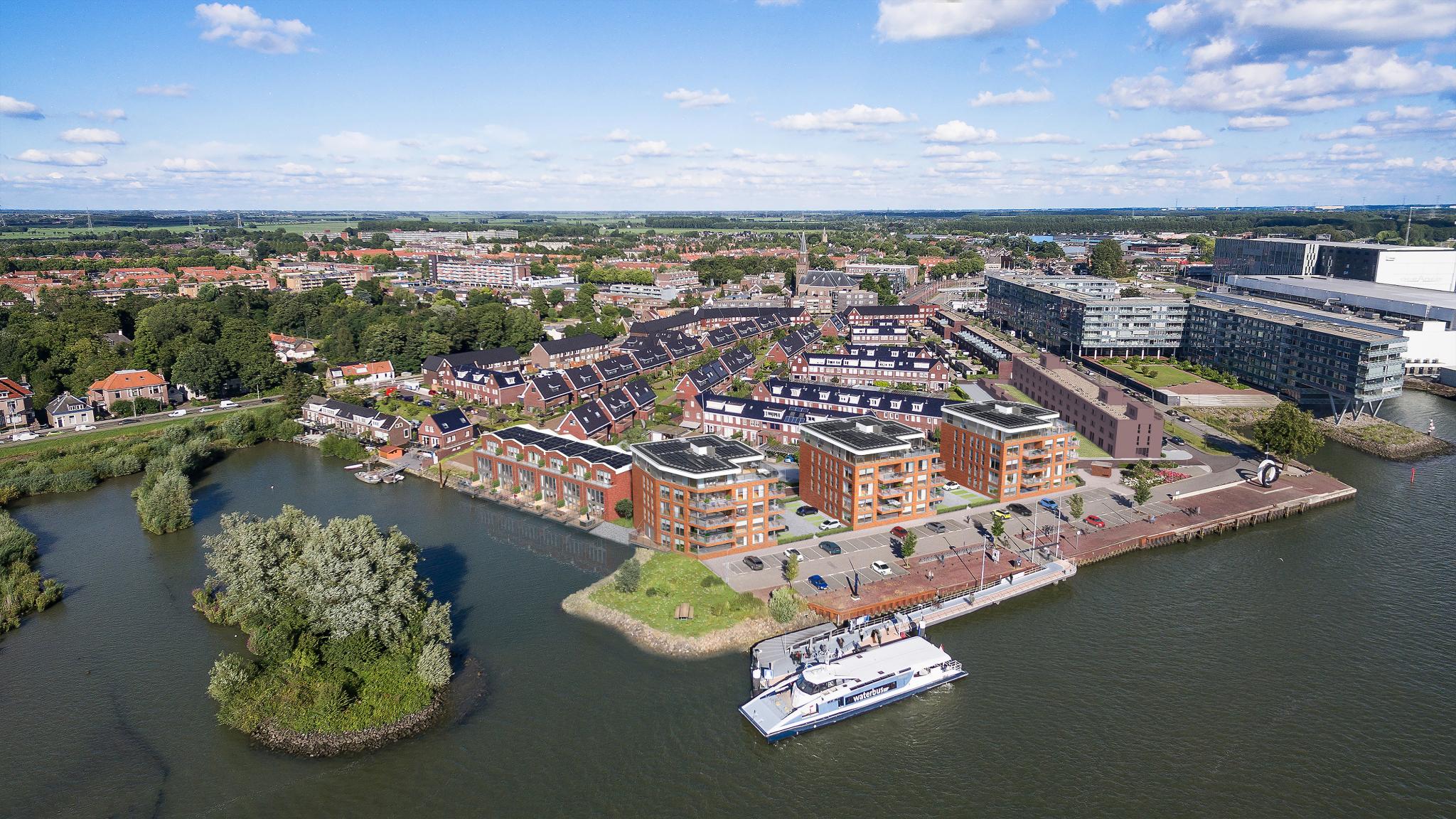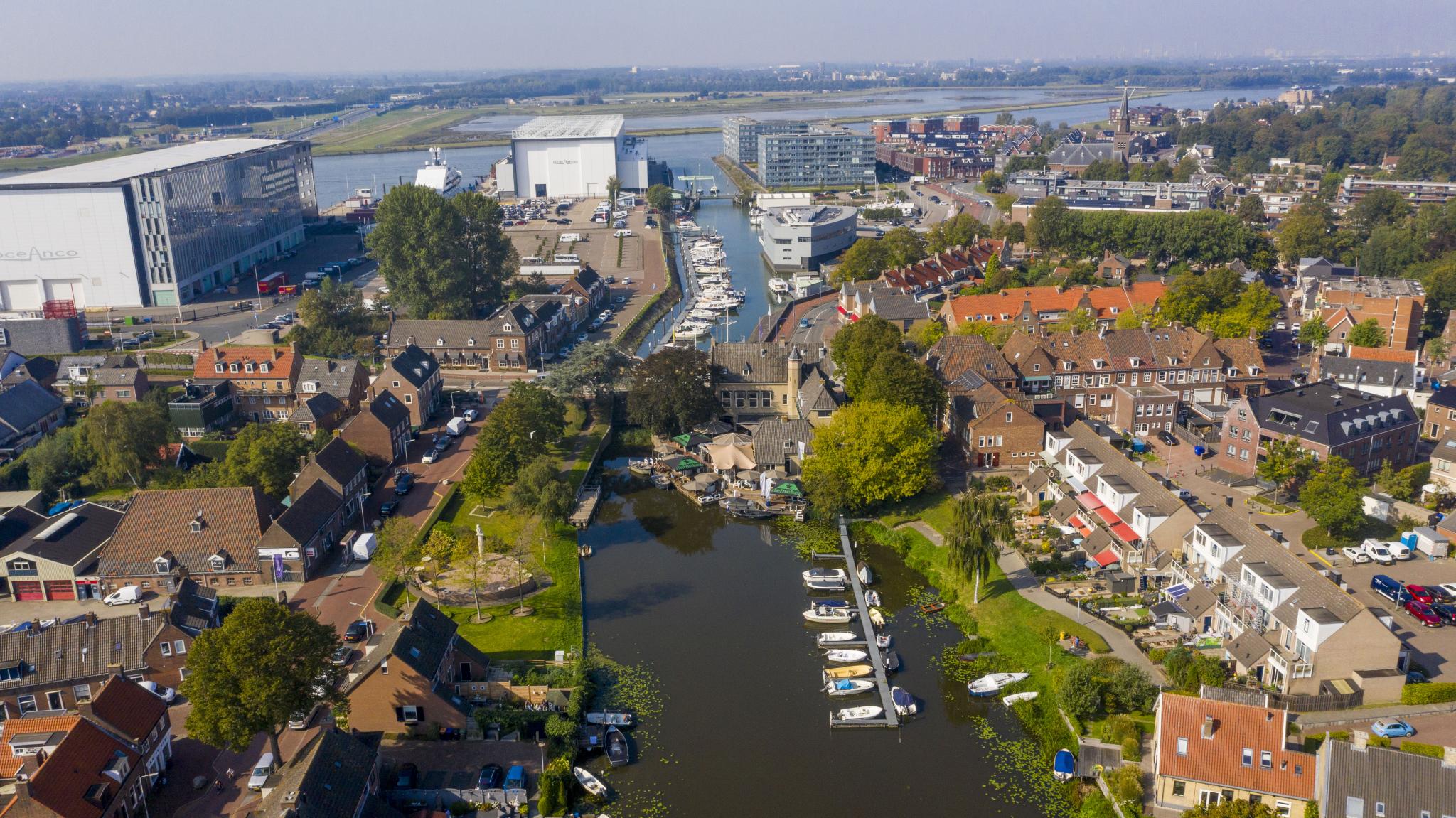Arie den Boer
The outer harbor of Alblasserdam, a village along the Noord river in West Alblasserwaard, has long been used as a berth for inland shipping. Since 1599 until its demolition in 1997, the outer harbor was connected with a lock to Alblas and Graafstroom to the river Noord. Following the closure of the Van der Giessen-de Noord shipyards at the end of the twentieth century, inland shipping and ship construction have been replaced by pleasure crafts, luxury housing and apartments along the dyke. Alblasserdam now has a jetty for passers-by on the way to the windmill complex of the World Heritage site Kinderdijk. This blog discusses the history of waterfront revitalization in Alblasserdam.
The river port of Alblasserdam has a long history. In 1812, Cornelis Smit bought a foreland from notary C.A. Pijl from Kinderdijk to the harbour of Alblasserdam. In 1814, he launched the 1st ship (Belder 2005). In June 1950, Cornelis Verolme bought the old shipyard Jan Smit Czn. The yard was drastically modernized in 1953 (Hengst 1995). Ship construction was going strong until the 1953 North Sea flood. On Sunday morning, February 1st, the dyke at the Noordhoek in Papendrecht broke on a length of more than 100 meters. In the following days, the southern part of Alblasserdam was flooded. The dyke in Papendrecht was repaired and the water was sucked away by large centrifugal pumps from the historic center of Alblasserdam into the Noord River.
While the water was pumped off from Alblasserdam, the use of the area started to change due to new flood defense measures. Following the flood, the national government developed the Delta Works Plan in the south-west of the Netherlands. As a result, the dykes were raised and strengthened on the basis of the latest insights about the sea and river levels. In Alblasserdam, according to the Delta Works Plan, the dyke reinforcement began in the 1960s. In 1977 the yard became part of shipyard Van der Giessen-de Noord (vdGdN), but the company started to decline. New structures protecting the city from floods, new shipbuilding technology and increasing ship sizes would ultimately lead to the closure of the shipyards, while the government decided to further raise the dykes. In 2000, van der Giessen de Noord sold the property to a project developer who wanted to convert the former shipyard into luxury residential area. This project developer went bankrupt in the financial crisis of the early 21st century.
After the bankruptcy of this developer, the municipality became owner of the site again and sold it at a profit to a second developer. Since then, the second developer has recently finished the residential area called Alblasserwerf with a lot of compromises in comparison to the original plan. The first spatial plan for the redevelopment had links to the past. The plan included references to the wooden saw windmill Ons Genoegen (Molen Database 2019), which had been demolished in 1952, with small water pools and floating futuristic homes. After the debacle of the first developer the next developer started with a new spatial plan that was profitable for all stakeholders. The second plan had little reference to the past, however. The wharf bridge and an old anchor remain as a former footprint of the yard (Alblasserdams Nieuws 2020). To bring the second plan to fruition, all stakeholders had to agree one way or the other to continue with the redevelopment and a building plan and zoning plan had to be approved (Rijksoverheid 2021).
Based on the analysis of council meeting reports (Boele & van Eesteren 2021), websites of local, regional and national press (Alblasserdams Nieuws 2010), documents from developers & others (Landschappartners 2018, HVE Architecten 2001, Kroon & de Koning 2019) and interviews with residents (Gemeente Alblasserdam 2014), I have studied the decision-making process and the nature of citizen participation. Citizens and civil society organizations are represented in the first place by the municipal council and the municipal heritage committee and can also start an initiative on their own.

In the process, however, citizen participation was limited to informing and consultation. According to Shirley Arnstein’s participation ladder (Cavar 2019), these forms of participation are merely degrees of tokenism. This tokenism (symbolic effort) is particularly visible in long term projects as Alblasserwerf and Zuidelijk Havengebied (Gemeente Alblasserdam 2019). As local governments involve citizens, civil society and businesses at an ever earlier stage, in the decision-making process of urban development, we need a renewed conceptualization of public space in line with Elinor Ostrom’s proposal of the Common Pool Resource (CPR), defined in economics as something between a public good and a private good.
The revitalization of the site and the lack of meaningful citizen engagement are also evident in other major interventions like dyke reinforcement. Dykes are often a boundary condition within river front developments. The dykes are tested by the water board every 12 years. The November 2020 test showed that the dykes near Alblasserdam no longer meet the objective of the Flood Protection Program. The water board sets up a new plan in response to the High Water Protection Program (HWBP) to further raise the primary dyke barrier to 5.1 metres above normal water lever (Gemeente Alblasserdam 2021). In the HWBP, 21 Dutch water boards and Directorate-General for Public Works and Water Management (Rijkswaterstaat) are working together on the largest dyke reinforcement operation ever since the Delta Works.

In the coming years, hundreds of kilometers of dykes will be strengthened, raising the question how local governments, citizens, civil society organizations and businesses collaborate to cope with these changes. In order to support the various processes of decision-making – including citizen participation – the Digital System Environmental Law (Digitaal Stelsel Omgevingswet) will be applied from July 1, 2022 in the Netherlands. It is paying special attention to citizen participation, which is crucial, because districts and neighborhoods are the lifeblood of a municipality. Citizens, civil society organizations and business should therefore be involved in planning and decision-making in a way that goes beyond tokenism, in order to make sure that common resources, such as cultural and historical values and objects, are an integral part of waterfront developments.
Acknowledgement
Arie den Boer is an external PhD candidate for citizen participation at the Erasmus University in Rotterdam. It was edited by the PortCityFutures editorial team: Carola Hein and Hilde Sennema. Special thanks to Didem Yerli.
References
Alblasserdams Nieuws. 2010. “Start Bouw van Nieuwe Wijk ‘De Havenmeesters’ Is in Zicht.” https://www.alblasserdamsnieuws.nl/wordpress/2010/10/17/bouw-van-nieuwe-wijk-de-havenmeesters-is-in-zicht/ (June 27, 2021).
———. 2020. “Gebiedsontwikkeling Alblasserwerf Voltooid; Anker Overhandigd.” https://www.alblasserdamsnieuws.nl/wordpress/2020/10/05/gebiedsontwikkeling-alblasserwerf-eindelijk-voltooid-gevonden-anker-overhandigd/ (June 30, 2020).
Belder, Bram. 2005. De Ouwe Werf van Cornelis Smit tot Cornelis Verolme 1812-2005. Albasserdam: De Stroombaan Alblasserdam.
Boele & van Eesteren. 2021. “Woningbouw.” https://www.boele.nl/projecten/alblasserwerf-de-hellingen-alblasserdam (June 27, 2021).
Cavar, Frano. 2019. “Public Participation on Redesignation Applications: Lessons for and from the City of Calgary’s Planning Process.”
Foster, Sheila, and Christian Iaione. 2020. “Commoning - Old Lock of Alblasserdam.” Commoning. http://commoning.city/project/old-lock-of-alblasserdam/ (June 27, 2021).
Gemeente Alblasserdam. 2014. “Concept Verslag van Het Overleg Tussen Bewoners Alblasserwerf - Alblasserwerf CV – Woonkracht10 En Gemeente Alblasserdam.” https://zaken.alblasserdam.nl/pls/idad/mozEgemDocument?F_DOCNR=3750106 (June 27, 2021).
———. 2019b. “Zuidelijk Havengebied Alblasserdam.” https://www.alblasserdam.nl/Inwoners/Alle_onderwerpen/Projecten/In_ontwikkeling/Havengebied (June 30, 2021).
———. 2021a. “Raadsinformatie Brief. Voortgang Zuidelijk Havengebied.” https://zaken.alblasserdam.nl/pls/idad/mozEgemDocument?F_DOCNR=8277618 (June 29, 2021).
Hengst, S. 1995. “De Toekomst van Het Vervoer over Water.” Delft maritiem 2.
HVE Architecten. 2001. “Verolme terrein, Alblasserdam.” HVE Architecten. https://hve-architecten.nl/projecten/verolme-terrein-alblasserdam/ (June 27, 2021).
Kroon & de Koning. 2019. “Samenwerkingsovereenkomst Kade Noord Alblasserdam.” https://www.kroondekoning.nl/nl/nieuws/detail/samenwerkingsovereenkomst-kade-noord-alblasserdam (June 27, 2021).
Landschappartners. 2018. “Alblasserwerf, Alblasserdam.” Landschappartners. https://landschappartners.nl/portfolio/alblasserwerf-alblasserdam/ (June 27, 2021).
Molen Database. 2019. “Ons Genoegen, Alblasserdam.” https://www.molendatabase.org/molendb.php?step=details&nummer=866 (June 27, 2021).
Rijksoverheid. 2021. “Stappenplan Bij Bouwen En Verbouwen.” https://www.rijksoverheid.nl/onderwerpen/bouwregelgeving/stappenplan-bij-bouwen-en-verbouwen (June 30, 2021).
Smit, Leen, and Adam Krijgsman. 1976. Schippers Op de Alblas En de Graafstroom. Offsetdrukkerij Kanters BV. https://www.biblio.com/book/schippers-op-alblas-graafstroom-smit-leen/d/1243065139 (June 27, 2021).
